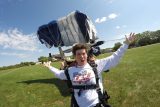What Is a Skydiving Cutaway?
Skydiving Training
Posted by: Wisconsin Skydiving Center 6 years ago
A skydiving cutaway occurs when a tandem or sport skydiver’s main parachute malfunctions. While many skydivers fear the eventuality at least a little bit (mostly, because they’re not terribly familiar with the flying characteristics of that other parachute they lug around), modern technology has made a “reserve ride” pretty much a no-biggie. Curious? Here are some fun things to know about that other piece of nylon.
How common of an occurrence is THe Skydiving cut away?
Because the equipment (and the jumper involved) varies significantly, the rates of malfunction also vary widely. An oft-quoted statistic is that a skydiver’s equipment will malfunction approximately once every thousand jumps or so. (Pretty good odds, we might say!)
What takes over when the first parachute is cut away?
That’d be the reserve parachute, which lives in a separate pocket up above the main in any skydiving container. Reserve parachutes are venerated objects, packed by FAA-certified riggers. They are sealed with a special metal tag and inspected every six months – even if they’ve been sitting waiting in the container since the last time they saw Mr./Ms. Rigger’s smiling face.
Is the reserve parachute the same as the main?

Nope! Lots of skydivers refer to their main solely as their “canopy,” and their reserve as the “parachute”. The main is designed more along the lines of fun.
The proportions and design of the main parachute for sport jumpers emphasizes performance and agility. Compare that to the much-larger, much-squarer proportions, and design of tandem parachutes, military parachutes, and student parachutes. Their equipment is designed to contribute to a flight as uneventful as a parachute ride after jumping out of a plane can possibly be — which is very much a question of perspective, of course.
It’s often the “fun” design characteristics of the main canopy that contribute to the malfunction. That’s why every sport skydiver goes through rigorous training and earns the right to pilot a fun-sized flying machine.
What happens to the main parachute after it is cut away?
Once the main canopy is cut away from the skydiver, it flies off into the sunset with the “free bag” it’s packed into when it’s placed in the container. Often, if the spot (the place over the ground where the skydiver exited the plane) was good and the day isn’t too windy, it’ll come down somewhere on the dropzone. If not, it’ll take a wonderful journey into the countryside. Then there it waits — in a tree, in the river, on a house, in a yard full of snarling dogs, deep in a field of sunflowers, on the road, or over some power lines. Only for the skydiver and her/his pack of true friends to recover again and celebrate with probably a little too much beer.
As of publication, the skydiving industry is still waiting for a definitive device to track a cutaway canopy via GPS to make this part a little less arduous. There have been several that almost solved the problem, but the device failed the final hurdle at the governmental stage or proved too unwieldy for the task. We know it’ll happen eventually. Fingers crossed for 2019.
Ready to become a certified skydiver? Learn all about how to get your A-license and other skydiving training info on our blog.
Categories:
You May Be Interested In:

How Long Does A Skydiving License Last?
1 year ago by Wisconsin Skydiving Center

Skydiving License 101: Understanding Different Types and Their Requirements
1 year ago by Wisconsin Skydiving Center

First Skydive – Tandem Skydive or Solo Skydive?
1 year ago by Wisconsin Skydiving Center

All About AFF Skydiving Training and How We Do It Better
2 years ago by Wisconsin Skydiving Center